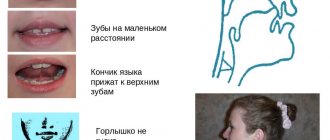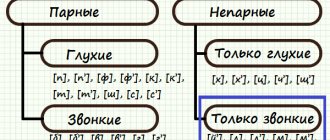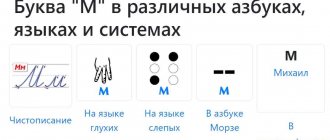Now you will learn about the letter and sound B.
B uratino, b ara b an,
B- tree, b- ulka and b- anan.
Who plays the trumpet ?
Our guest, b ukva " B "!
As you learned earlier, letters come in vowels and consonants. We became familiar with the vowel sound [a] and its letter, and you know that when we pronounce a vowel sound, the air comes out freely, without encountering any obstacles on the way. If the air meets obstacles, it means a consonant sound is pronounced.
In this lesson we will learn about the letter B and its sound, the first letter of the alphabet with a consonant sound.
When pronouncing the sound [b], the air encounters an obstacle on the way, we cannot sing such a sound, this sound is a consonant.
Let's pronounce this sound in words: b a b ochka, b fir-tree, b mustache.
We will hear a ringing voice. The sound [b] is sonorous. Let's determine whether the sound [b] is hard or soft.
Let's compare the words: bashnya , b white.
In one word the sound [b] is hard, in the second the sound [b´] is soft. The letter is the same, but the sounds are different. In this case, for the correct pronunciation of words with B , the helper letters that come after will help us. If followed by the letters E, Yu, E, I, I , then the consonant sound is soft. If followed by the letters O, A, U, Y , then the consonant sound is hard.
The letter B denotes a consonant, voiced sound, which can be either hard or soft.
The letter B in Russian behaves actively and can appear anywhere in a word. For example, a ballerina.
At the beginning of the word, a hard sound [b] is heard, since the letter B is followed by the letter A , which indicates the hardness of the consonant sound.
The word be gun. At the beginning of the word, a soft sound [b´] is heard, since the letter B is followed by the letter E , which indicates the softness of the consonant sound.
Let's remember the words in which the letter B is in the middle of the word. Guess the riddle:
We returned at a late hour.
Who greets us at the door?
Who wags his tail with happiness
And he dances on his hind legs...
(E. Grudanov)
Answer: so ba ka
In the middle of the word, a hard sound [b] is heard, since the letter B is followed by the letter A , which indicates the hardness of the consonant sound.
Let's look at words with a soft [b´] in the middle: ki bi tka.
In the middle of the word, a soft sound [b´] is heard, since the letter B is followed by the letter I , which indicates the softness of the consonant sound.
Let's look at words with the letter b at the end.
The word table b .
A word is written with the letter B at the end, but when you pronounce the word pillar, the sound [p] is heard. We'll soon find out why this happens. Let's name words in which the letter B occurs more than once: b o b er, b a b ochka, b u b lik, b u b e n, b a b ushka, b a o b a b.
Guess the riddle, the letter B :
Without worrying about the weather,
in a white ,
And on one of the warm days
May gives her earrings.
Answer: birch .
Let's count how many letters B , hard and soft sounds [b] are in the riddle. This riddle contains two letters B , one hard sound [b] and one soft sound [b´].
This letter has a funny belly and looks like a hippopotamus.
return to the page “Russian language 1st grade” >>>
If you liked it, share it with your friends:
Join us on Facebook !
Conversational Russian – Real Language Club
See also:
- Russian texts with audio
- Dialogues in Russian
- Video in Russian with subtitles
- Correct pronunciation exercises
- Russian tongue twisters in audio format
- Common phrases in Russian
- Russian slang expressions
- Jokes in Russian with translation into English
Preparation for Russian language exams:
- OGE in Russian language
- Unified State Examination in Russian
- Exams for migrants (Patent, temporary residence permit, residence permit, Russian Federation citizenship)
We recommend:
- The best Russian tutors
The most necessary from the theory:
- Grammar of Russian language
We suggest taking tests online:
- Russian proficiency test
- Russian vocabulary test
- Russian grammar tests
- What language should I learn?
Recommended articles and videos:
- How to successfully pass an interview in Russian
- TV is a means of learning a foreign language
- Interesting tests: find out your level of language proficiency
- Gymnastics for linguists: a complex for correct pronunciation
- 5 rules for successful language learning
- How to improve your knowledge of a foreign language: three tips and five rules
- How to improve your speaking fluency
- Video: “How to improve pronunciation and understanding
More articles >>>
How to teach a child to distinguish sounds
Children perceive information best if it is presented in a playful way. Together with your child, come up with an interesting story that will help explain the complex relationship between hard and soft consonant sounds.
Once upon a time, hard and soft sounds lived together. There was no enmity or quarrel between them, until one day an ambitious group of vowels, which included E, Yo, Ya, Yu and I, wanted to gain power over everyone. A war began that lasted for many years. A, O, U, E and S remained neutral and preferred to stay away, because they could not take anyone’s side. The war dragged on, so the vowels decided to use cunning. They turned for help to a soft sign, which does not have its own sound at all, but loves to pit others against each other.
This harmful letter told the vowels about the place where the consonants were hidden, and in return demanded a number of privileges after the successful completion of the military campaign. As a result, the consonants were surrounded. A group of militant vowels gave them an ultimatum and those who agreed had to accept their terms. The war was lost and the winners celebrated their success with pomp.
A small group of vowels received undivided power. Now they determine whether the consonant sound will be soft or hard. The soft sign received exactly the same rights. Now he, too, can push around the vanquished. Although among those who agreed there were also those who did not want to put up with the circumstances. All the hissers, along with a couple of comrades-in-arms, did not raise the white flag and went to partisans in the forests. The compliant consonants now strictly obey the laws of the vowels, and a few rebels continue to carry out sabotage activities, although without much results.
This simple story clearly demonstrates the peculiarities of the relationship between vowels and consonants. The names of the rebels that we will mention later should be immediately blacklisted. They are still wanted by the vowels for their disobedience. A "Wanted" sign can be placed on the refrigerator or near your little student's desk.
This hint should be constantly in front of the child’s eyes. The remaining consonants, which submitted to the victors, are now forced to become either soft or hard depending on their neighbors. If they are followed by the vowels E, E, I, Yu, I or b, then they become soft because they lose their will in front of the winners. If another vowel (A, O, U, E or Y) or consonant lands on their tail, then they become firm, as they feel support.
Table of hard and soft sounds
All rules are collected in one table. At first glance, it may seem like gobbledygook to a child, but after accessible explanations and careful study, the new material will no longer seem so complicated.
Print and hang this picture in a visible place so that your child can learn these rules at any convenient time.
Voiced and unvoiced sounds
Consonant sounds are also classified into voiced and voiceless. The former consist of voice and noise, while the latter consist only of noise.
The voiced category includes: [B], [G], [D], [F], [Z], [V], [Y], [L], [M], [N], [R].
The deaf group includes: [К], [П], [Х], [Ц], [Ч], [С], [Т], [Ф], [Ш], [Ш].
Most consonants can form pairs based on deafness and hardness:
[B]—[P] [V]—[F] [D]—[K] [D]—[T] [G]—[S] [W]—[W]
Voiceless and voiced consonants are easy to remember using two sentences:
- “The Lion and the Toad Have Many Friends” (Voiced)
- “Styopka, do you want a cheek? - Ugh!" (Deaf).
You can memorize them or print them out on a separate card.
Always hard and soft sounds
Now it’s time to find out the names of those very rebels who did not want to surrender to the enemy without a fight. The sounds Ch, Shch and Y are always soft, but C, Zh, Sh can only be hard. These are six consonant sounds that are still waging their quiet war and do not want to submit to the power of vowels. It doesn't matter who they happen to be next door to. The steadfastness of these sounds is admirable.
Article:
The sounds [b], [b' - b] normally appear in a child between the ages of 0 and 1 year.
If a child at 1 year old does not have the sounds [b], [b'], visit a consultation with a speech therapist who works with young children.
How to pronounce the sound [b].
- Vocal cords are closed and trembling;
- The teeth are open;
- The lips are closed at first, then they open under the pressure of the air stream;
- The tongue is passive, spread wide, the tip is moved away from the front lower incisors, moved back;
- The soft palate is pressed against the back wall of the pharynx.
- Articulatory features of sound [ b ] .
[b] – consonant sound. The air escaping from the oral cavity meets a barrier, closed lips;
[b] – mouth sound. The soft palate is raised, the small tongue is pressed against the back wall of the pharynx, air enters only into the oral cavity;
[b] – ringing sound. When pronouncing the sound [b], the vocal cords are closed, vibrate, and a voice is formed;
[b] – stop-plosive sound according to the method of formation. The bow is formed by the lips;
[b] – labial-labial sound at the place of formation. A barrier to the air stream is formed by the lower and upper lips.
- Acoustic signs of sound [ b ] .
[b] – the sound is ringing, noisy, instantaneous;
[b] - hard sound - the middle part of the back of the tongue does not take an active part.
- Sound disturbances [ b ] .
The pronunciation of the sound [b] is extremely rarely violated:
- absence of sound [b] - with pronounced defects of the lips.
- replacement of the sound [b] with the labiodental sound [v], with the sound [m] with open rhinolalia.
- mixing the sound [b] with the sound [p] - interchanges often towards deafening.
How to pronounce the sound [b'].
- Vocal cords are closed and trembling;
- The teeth are open;
- The lips are pressed more closely to the teeth, the corners are slightly moved apart;
- the tongue moves forward, the front and middle parts of the back rise to the hard palate.
1). Articulatory features of the sound [b'].
[b'] – oral sound. The soft palate is raised, the small tongue is pressed against the back wall of the pharynx, air enters only into the oral cavity;
[b'] – consonant sound. The air escaping from the oral cavity meets a barrier, closed lips;
[b'] – voiced sound. When pronouncing the sound [b'], the vocal cords are closed, vibrate, and a voice is formed;
[b'] – stop-plosive sound according to the method of formation. The bow is formed by the lips;
[b'] – labial-labial sound at the place of formation. A barrier to the air stream is formed by the lower and upper lips.
2). Acoustic signs of sound [b'].
[b'] – sonorous, noisy, instantaneous sound;
[b'] – soft sound. The middle part of the back of the tongue rises towards the hard palate.
3). Sound disturbances [b'].
The pronunciation of the sound [b'] is violated extremely rarely:
- absence of sound [b'] - with pronounced defects of the lips.
- replacement of the sound [b'] with the labial-dental sound [v'], with the sound [m'] with open rhinolalia.
- mixing the sound [b'] with the sound [p'] - interchanges often towards deafening.
How to teach children to distinguish between hard and soft consonants
The very first thing you need to teach your child: consonant sounds can be hard and soft, but not letters.
Typical mistake: Children confuse sounds and letters. We remember that a sound sounds, and a letter is an icon, it is written. A letter cannot be hard or soft; only a consonant sound can be hard or soft in pronunciation.
Sometimes children can easily learn to distinguish soft and hard sounds by ear. But it happens that this is difficult, and in this case signs will come to the rescue by which you can distinguish hard sounds from soft ones.
Recording sounds
In transcription, the softness of a consonant sound is indicated by adding the symbol ' to its notation. This is an apostrophe that appears in some loanwords.
For example, to indicate the softness of the sound P in transcription, you need to write [p']. The hardness of the sound is not indicated.
There's nothing complicated about it. Offer your child a simple task. He needs to write out from a group of words only those that contain soft consonants, and then transcribe them with an apostrophe. Just a few of these exercises, and he will quickly remember how softness is indicated.
Distinctive features of soft and hard sounds
What sound comes after a consonant:
- If after a consonant there is a vowel a, o, u, e, s, then the consonant is hard.
- If after a consonant there is a vowel and, e, yu, i, then the consonant is soft.
Practice with examples: In the words “mother” and “nora” the consonants are hard, because they are followed by “a” and “o”. In the words “fly” and “nanny” the consonants are soft because they are followed by “e”, “i”, “ya”.
- If another consonant sounds after a consonant, then the first consonant will be hard.
- There are sounds that can only be hard and sounds that can only be soft, no matter what sound is heard or what letter is written after them.
Always hard sounds - zh, sh, ts. Always soft - th, h, shch. A common way to learn these sounds is a simple technique: we write the letters that convey these sounds on a line, and emphasize “th, ch, sch.” The underscore symbolizes the cushion on which the soft sounds sit. The pad is soft, which means the sounds are soft.
Soft sign and hard sign
- If there is a consonant at the end of a word and the letter “b” after it, then the consonant is soft.
This rule is easy to apply if the child sees the written word, but it will not help if the child performs the task by ear.
Movement of the tongue when pronouncing soft and hard sounds
When pronouncing a soft sound, the tongue moves slightly forward, approaching (or touching) the palate with its middle. When pronouncing hard sounds, the tongue does not move forward.
Examples of interesting tasks for developing the skill of distinguishing between soft and hard consonants
A picture or simply a list of thematic words is shown, and the task is given to choose words with soft or hard consonants. For example:







